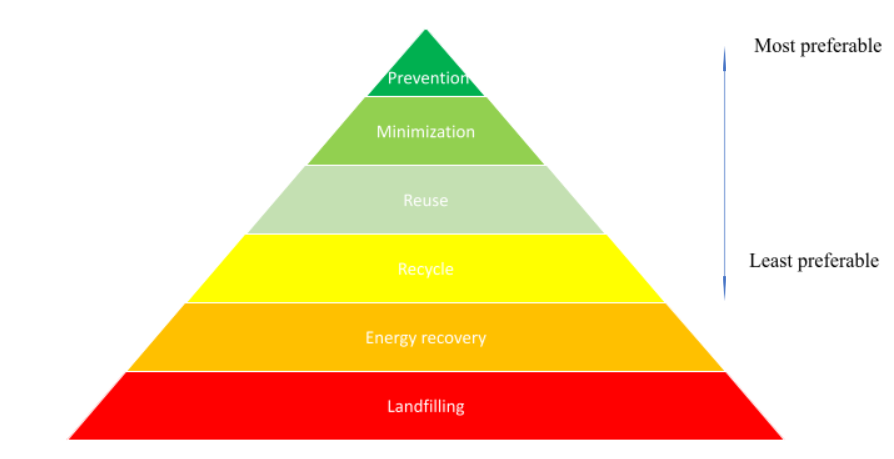The waste hierarchy pyramid
Posted by Ioanna

When discussing about ways to reduce the waste we produce, it is always useful to keep in mind what is called “the waste management hierarchy pyramid”. This pyramid consists of multiple layers, put in the order of the most preferable waste management option to the least desirable from an environmental and sustainability point of view, with arrows indicating the directions, as shown in Fig. 1.
The waste management terms in the different layers of the pyramid can be explained as follows:
- Prevention: No waste is created in the first place. This is the most desirable option. For example, in your everyday life, ask yourself if you really need to buy something, before you proceed with the purchase. By not buying things you don’t need, you prevent waste to be created.
- Minimization: Although some waste has been produced, care has been taken so that it is the least amount possible. For instance, instead of buying 5 pairs of jeans, rethink if it is necessary to buy all of them or 2 will be enough.
- Reuse: Reuse means that one object is used multiple times (however it says nothing about the quantity of the objects/waste, and this is why it is less preferable than minimization). Ceramic dishes can be used multiple times for years; however, this is not the case for disposable paper/plastic dishes.
- Recycling: In this process, the materials are broken down in order to be used again to produce similar products with the initial ones (eg waste glass bottles are crushed, cleaned and melted and then this glass is used for the production of new glass bottles). With recycling, materials can be recovered from the waste and be reused. However, recycling demands energy, and this is why it is not in the top of the pyramid. In your everyday life, you can recycle many things (packaging, electronics, batteries, lamps) by putting them in the correct recycling bins.
- Energy recovery: The waste in this case is treated thermally, so that some energy can be recovered by this process. Most of the times the waste is incinerated, ie burnt under controlled conditions and the energy produced is used for heating. No materials are recovered from this process, but only energy. However, this process also needs some energy in order to take place. In Sweden, what you put in the normal bins for household/municipality waste ends up mainly in the incineration plants.
- Landfilling: This is the last waste management option and the least desirable of all. The waste is deposited in a landfill and (usually) no materials or energy is recovered. In Sweden, what is left after incineration is landfilled.
How CSS works on these waste management options:
- Prevention & minimization: By informing the students and the public about the environmental challenges, we raise awareness and help people rethink about their choices and lifestyle, how much waste they produce and how they can prevent or reduce it.
- Reuse: Our most popular event, Re:cycle, gives the chance to all of our members to get a free bike by repairing a second hand one, with assistance from us and other professionals. Clothes swaps also promote reuse of unwanted clothes collected from students.
- Recycle and Energy Recovery: During our waste pick ups we pick up a lot of waste from different places in and around Gothenburg. We separate the cans from the rest rubbish and recycle them. The rest of the trash goes to the normal bins from where it will eventually end up to the energy recovery facilities.
